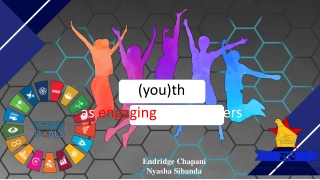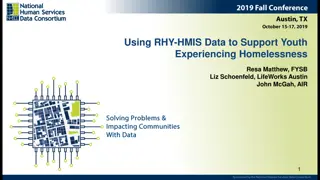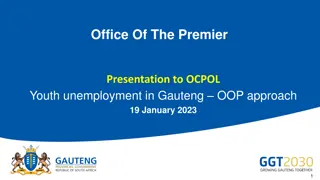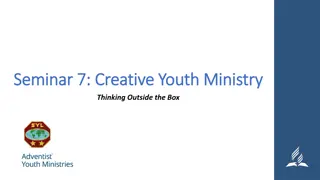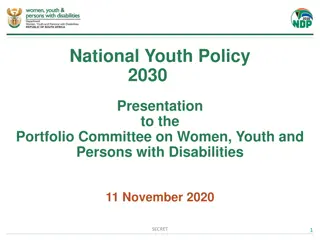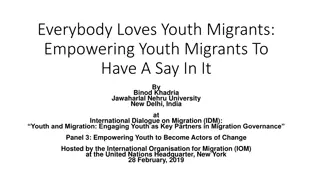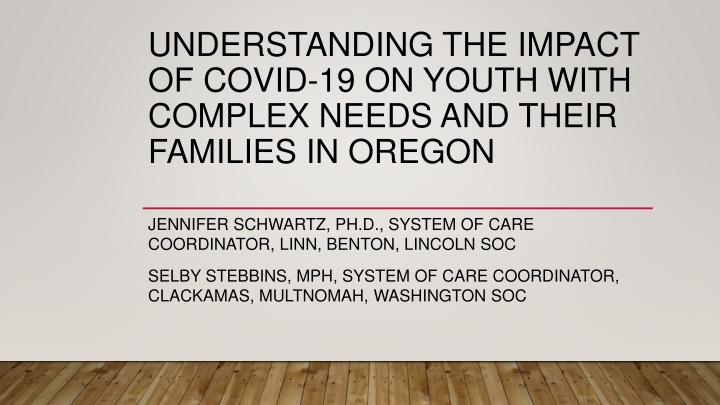
Impact of COVID-19 on Youth with Complex Needs in Oregon
Explore the impact of COVID-19 on youth with complex needs and their families in Oregon, as studied by Jennifer Schwartz, Ph.D., and Selby Stebbins, MPH. The research delves into the challenges faced, successes, and innovations during the pandemic based on surveys conducted at the start and six months later.
Download Presentation

Please find below an Image/Link to download the presentation.
The content on the website is provided AS IS for your information and personal use only. It may not be sold, licensed, or shared on other websites without obtaining consent from the author. If you encounter any issues during the download, it is possible that the publisher has removed the file from their server.
You are allowed to download the files provided on this website for personal or commercial use, subject to the condition that they are used lawfully. All files are the property of their respective owners.
The content on the website is provided AS IS for your information and personal use only. It may not be sold, licensed, or shared on other websites without obtaining consent from the author.
E N D
Presentation Transcript
UNDERSTANDING THE IMPACT OF COVID-19 ON YOUTH WITH COMPLEX NEEDS AND THEIR FAMILIES IN OREGON JENNIFER SCHWARTZ, PH.D., SYSTEM OF CARE COORDINATOR, LINN, BENTON, LINCOLN SOC SELBY STEBBINS, MPH, SYSTEM OF CARE COORDINATOR, CLACKAMAS, MULTNOMAH, WASHINGTON SOC
WHO WE ARE System of Care (SOC) governance structures Monitor access to and quality of the service array for young people with complex needs and their families. Promote System of Care values within the service array: Services ought to be youth and family guided, home and community based, culturally and linguistically responsive, and coordinated. Include representatives from child-serving agencies, coordinated care organizations, community organizations, and youth and family.
INTRODUCTION & METHODOLOGY Purpose: To create a snapshot of barriers and successes to serving young people with complex needs and their families at the start of the COVID-19 epidemic and six months later. Method: In April and September, we conducted a survey of local System of Care Executive Council leads. Limitations: This is a quickly developing situation and barriers and successes will continue to be shaped by events related to the coronavirus. The data collected was open-ended and qualitative.
SURVEY QUESTIONS 1. What are the three main issues related to COVID-19 impacting children and their families who needed services from multiple systems in the past month? 2. What are the three main issues related to COVID-19 impacting the services and support system for children and their families in the past month? 3. What are the successes or innovations related to COVID-19 that have happened in the past month?
1.Technology Lack of access, difficulty navigating telehealth services 2. Mental Health Fear, stress, isolation 3. Parenting Lack of daily structure & lack of childcare 4. Difficulty meeting basic needs (food) KEY FINDINGS APRIL 2020 FAMILY IMPACTS COVID-19
1. Technology Challenges related to transitioning to telehealth/online services Families lack of Internet service and devices KEY FINDINGS APRIL 2020 2.Workforce Decrease in staff morale, lack of connectivity, staffing shortages SERVICES & SUPPORTS COVID-19 3. Foster children Lack of in-person visits with parents Lack of respite
1. Growth in the array of telehealth services KEY FINDINGS APRIL 2020 Teletherapy, telemedicine, skills training Introduction of news forms of communication within communities State approval of telehealth services INNOVATIONS COVID-19 2. Resource sharing among community partners
1. Technology issues 1. Lack of access to and quality of Internet service, lack of devices, lack of efficacy and comfort, telehealth refusal, device addiction 2. Homeschooling, especially for working parents 3. Lack of childcare 4. Lack of work KEY FINDINGS SEPTEMBER 2020 FAMILY IMPACTS COVID-19 13 of 16 local SOC groups
Technology Families lack of Internet service and devices Lack of privacy to engage in therapy KEY FINDINGS SEPTEMBER 2020 Challenges of online engagement Education (lack of school-based services) SERVICES & SUPPORTS COVID-19 Lack of home and community based services (respite, personal support workers, skill builders, etc.) 13 of 16 local SOC groups
Growth in telehealth services Increase in video/phone delivery of a variety of services Maintenance of workflow governance structures, staff, care coordination meetings & trainings Increase in client engagement (interactive games, virtual Sandtray) Increase in access via hot spots and kiosks Increase in computer literacy among families KEY FINDINGS SEPTEMBER 2020 INNOVATIONS COVID-19 13 of 16 local SOC groups
Families: Lack of Internet service and devices Services: Lack of home and community based services APRIL TO SEPTEMBER SIMILARITIES IN IMPACTS Innovations: Growth in the array of online services & INNOVATIONS
Families stress and anxiety related to COVID- 19 lessened Families lack of knowledge about telehealth services shifted to a lack of efficacy Families struggle with organizing daily activities for their children shifted to a struggle supporting distance learning Families need for computers, tablets and phones to access services shifted to a need for supplemental technology (camera, headphones, apps, etc.) APRIL TO SEPTEMBER SHIFTS IN IMPACTS & INNOVATIONS
Service providers moved from figuring out how to deliver online services to focusing on how to remotely engage clients By September, service providers had developed many innovative solutions to increase client engagement APRIL TO SEPTEMBER SHIFTS IN Service providers moved from concerns about maintaining staff morale and connectivity to increasing productivity via remote work IMPACTS & INNOVATIONS Families computer literacy increased
Similarities & Differences Impact on families Families lacked access to Internet service Families lacked access to devices (computers, headphones) Families lacked telehealth knowledge Families had more mental health concerns (fear, stress, anxiety) Families lacked a daily structure for children Families lacked telehealth efficacy Families lacked support for distance learning Impact on services Lack of home and community based services Challenge of providers delivering video/phone services Challenge of maintaining staff morale and connectivity Challenge of engaging clients via video/phone services Innovations Growth in array of video/phone services Increase in client engagement via video/phone services Increase in providers remote productivity Increase in client computer literacy APRIL SEPTEMBER


